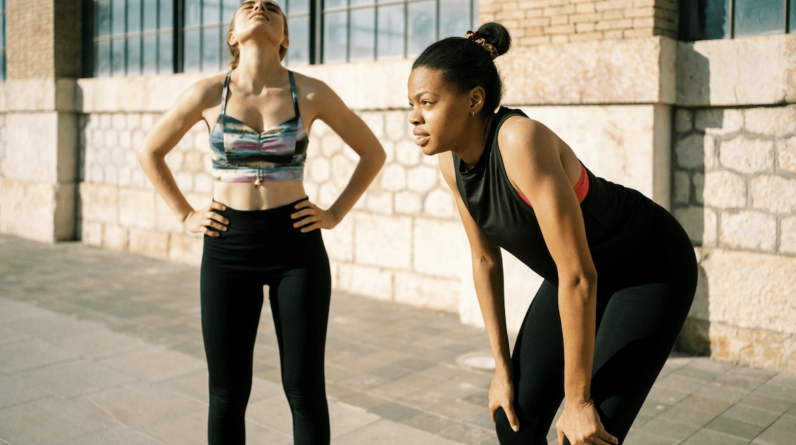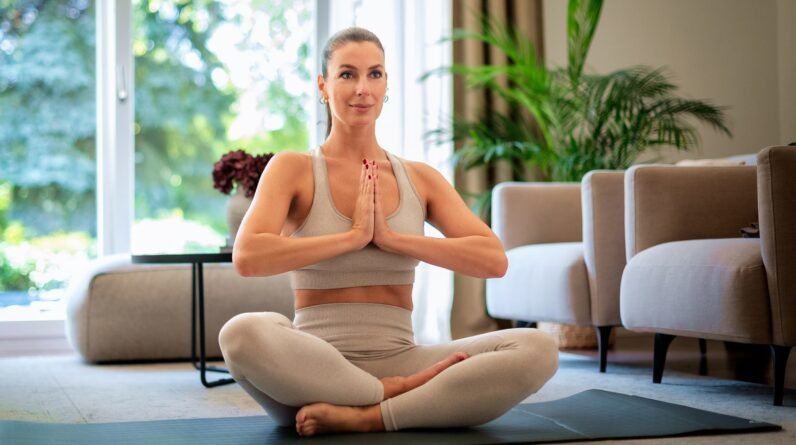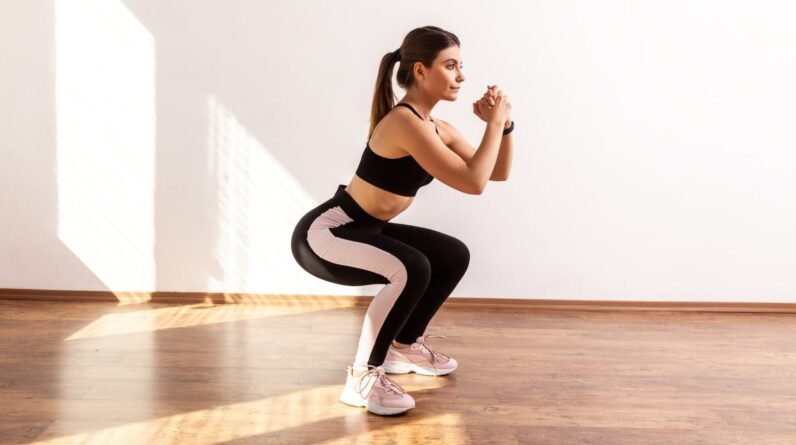
But, nope! Sometimes, it’s the opposite. I try to “listen to my body,” but my body doesn’t always tell me to move. My mind is tired and distracted. Honestly—if it wasn’t for my fitness watch reminding me to get off my duff, I’d have very few daily steps.
As a registered dietitian, I wholeheartedly embrace intuitive eating and gentle movement. Gone are the days when I would force myself to do long, extreme workouts for the calorie burn. I don’t feel guilty about skipping the gym. However, I frequently need to make myself work out.
Ironically, when I coax myself to move, I’m motivated to do more. The saying, “A body in motion stays in motion” seems to ring true. So how do you strike a balance between intuitive movement and pushing yourself?
We chatted with some mental health and intuitive movement specialists to dive deep into the idea of motivation and exercise. Here’s what they had to say.
Are you high-energy or low-energy?
Your energy level (of course) plays a role in your desire to be active. You know a high-energy person when you see one: busy darting from one task to the next, and they never seem to tire. Then some folks are chill—content to sit for hours at a time with little to no movement.
Saba Harouni Lurie, LMFT, a licensed marriage and family therapist and owner and founder of Take Root Therapy, explains why our drives vary. “So many biological, psychological, and environmental factors influence our differing energy levels,” she says.
It may be in your genes. “Genetic factors can affect our energy levels, as some people may inherit lower energy from their families,” Lurie says. But our genes are just the tip of the iceberg.
“Sleep and nutrition will also influence your energy levels, as we need rest and nourishing foods to replenish our bodies to access energy. Mental health is also a factor, as some mental health challenges can make it difficult to find energy,” she says. “And chronic stress can take a toll on our bodies and contribute to feelings of fatigue. Plus, those of us raised in families where physical fitness and movement weren’t prioritized or prized, it can be challenging to engage in these activities and prioritize them as adults.”
While those with high energy levels may find it easier to prioritize movement, lower-energy folks need to be a bit more intentional.
While those with high energy levels may find it easier to prioritize movement, lower-energy folks need to be a bit more intentional. “It’s helpful to accept that you’re not someone who is naturally high energy or excited to move, and that’s okay,” Lurie says. “Starting from a place of acceptance and non-judgment can allow you to consider who you are and what’s realistic for you as a starting point.”
Motivation to exercise
I’ve accepted that I’m a mellow person, but I know I need to get regular movement for my health—and I know from experience that it feels good.
“It’s normal to want to move your body but to struggle to actually get yourself to move,” says Alexis Hart, LMSW, a licensed clinical social worker and eating disorder specialist in Michigan says. So where does motivation come from?
Intrinsic motivation vs. extrinsic motivation
Let’s explore the idea of motivation: Research has found that 1a person is either intrinsically or extrinsically motivated.
Extrinsic motivation is fueled by some outside source. Diet culture is steeped in extrinsic motivation. For example, you work out to lose weight/inches or to avoid shame. You choose the stair-stepper, not because you like it, but because it burns the most calories. Or your loved one or medical provider wants you to exercise. You “have” to do it.
On the other hand, intrinsic motivation comes from within. You truly enjoy movement and you’re excited about doing it. It’s satisfying. Rather than suffering through a workout, you “want” to participate.
So which one sounds the most conducive to regular movement? Intrinsic motivation. If you love doing something, you’re more likely to follow through. However, because of past experiences, you may tie physical activity to misery.
The key is to switch from extrinsic to intrinsic motivation. “Oftentimes, people who hate exercising have a history of exercising in a punishing, exhausting, or unsustainable way. For these folks, intuitive movement will be a powerful shift in how to think about exercise,” says Hart. “In general, intuitive movement will feel gentle on your body and leave you feeling refreshed afterward. That refreshed feeling is often what makes people want to continue to practice intuitive movement.”
What is intuitive movement?
Intuitive movement is anything you desire. You tune in to what your mind and body want. You’re not paying attention to rigid rules or metrics like calorie burn. Rather you are finding something you truly enjoy doing.
You also use your body’s signals to guide your movement. The mantra, “No pain, no gain” is not honoring your body’s internal cues. When something hurts with intuitive movement, you don’t keep pushing.
“Because intuitive movement is meant to be pleasurable and not punishing, it’s often easier to start, especially on low-motivation days. Often folks notice that once they start, they feel more energetic and motivated to continue,” Hart says.
How to gently nudge yourself to movement
If you’re used to “disciplining” yourself with rigorous physical activity, the idea of intuitive movement may seem foreign. You’re also not likely to feel internally motivated after a long day of mental work. Here are some tips to get energized and moving:
Start small
Knowing you have to do a 30-to 60-minute workout can be daunting, especially if you’ve been working all day.
“Pick a type of movement that is fun and accessible (e.g. walking the dog, dancing at home, yoga at your desk, your favorite sport) and commit to 5 minutes—no more, no less!” says Hart. “If after 5 minutes, you’re not feeling better, allow yourself to stop. If the movement is feeling good, it’s okay to go for longer, but be sure to to stop before you’re fatigued.”
Over time, she explains, this will build your mind-body connection and self-trust, which are both key to moving intuitively.
Choose fun
Crank up the tunes and dance. Set walking dates with your bestie. Take a karate or self-defense class. Or just play with your kids. Remember: Movement doesn’t have to be at the gym.
“I always encourage my clients to consider what they’re doing that’s already aligned with their desire to move and see if they can do more,” Lurie says. “That might be taking your dog for a walk or taking the stairs when you get to the office.”
Add variety
When you’re changing things up, you’ll be more motivated2 to exercise. You don’t have to do the same thing all of the time. Whether you have workout seasons or you mix weight training with yoga and running, variety will keep you interested.
It’s often when I’m in the routine of doing the same workouts that I lack motivation to move. Looking up a new fitness video or allowing myself to go “off-plan” gets me excited to exercise.
Avoid comparing
We tend to compare what we are doing (or what we look like) with those around us. But you don’t have to follow anyone’s regimen if you don’t like it.
“It has helped me to know that what works for others may not work for me, and that’s okay,” Lurie shares. “Allowing myself to honor what is pleasurable for me and what I enjoy has been liberating and encouraging.”
Gentle movement is still exercise
Caroline Young, MS, RD, RYT, registered yoga teacher and owner of Whole Self Nutrition, is a believer in gentle movement for the connection factor. “Forms of gentle movement, like yoga or tai chi, are embodiment practices, meaning they help you connect or reconnect with your body, including to its messages and needs.”
“When you’re connected to your body in such a way, chances are high that you will notice when it needs to move throughout the day, along with all of its other needs like hunger and thirst,” Young says. “When intentionally connecting to your body through embodied movement, you are letting it know that you are there to honor its needs, including when it needs a walk, stretch, or dance.”
Clean up negative self-talk
It can be helpful to ditch your limiting beliefs. Young shares examples of such thoughts:
- “It only counts if I exercise for 45 minutes.”
- “Walking isn’t exercise.”
- “Yoga isn’t enough.”
- “I have to exercise to eat what I want.”
- “If I eat dessert, I have to exercise more.”
These ideas tend to stem from a diet mentality and “force” you to exercise, which isn’t sustainable.
“Those [ideas] need to be acknowledged, explored, challenged, and replaced by healthy beliefs and behaviors, so you can reclaim exercise and let it be one part of your self-care routine and a source of joy in life,” encourages Young.
Allow yourself to rest
Your lack of desire to move may be rooted in fatigue. If a short walk doesn’t boost your energy, relaxation may be what you need.
The 5-minute trick is usually enough to snap me out of work mode and recharge my batteries. But if I still feel sluggish, I permit myself to stop. Intuitive movement respects the body’s cues.
“Motivation often follows activity but not always,” Hart says. “Sometimes our bodies are genuinely craving rest, and honoring this is an important part of an intuitive movement practice.”
Well+Good articles reference scientific, reliable, recent, robust studies to back up the information we share. You can trust us along your wellness journey.
- Ntoumanis N, Ng JYY, Prestwich A, et al. A meta-analysis of self-determination theory-informed intervention studies in the health domain: effects on motivation, health behavior, physical, and psychological health. Health Psychol Rev. 2021;15(2):214-244. doi:10.1080/17437199.2020.1718529
- Sylvester BD, Standage M, Ark TK, et al. Is variety a spice of (an active) life?: perceived variety, exercise behavior, and the mediating role of autonomous motivation. J Sport Exerc Psychol. 2014;36(5):516-527. doi:10.1123/jsep.2014-0102







